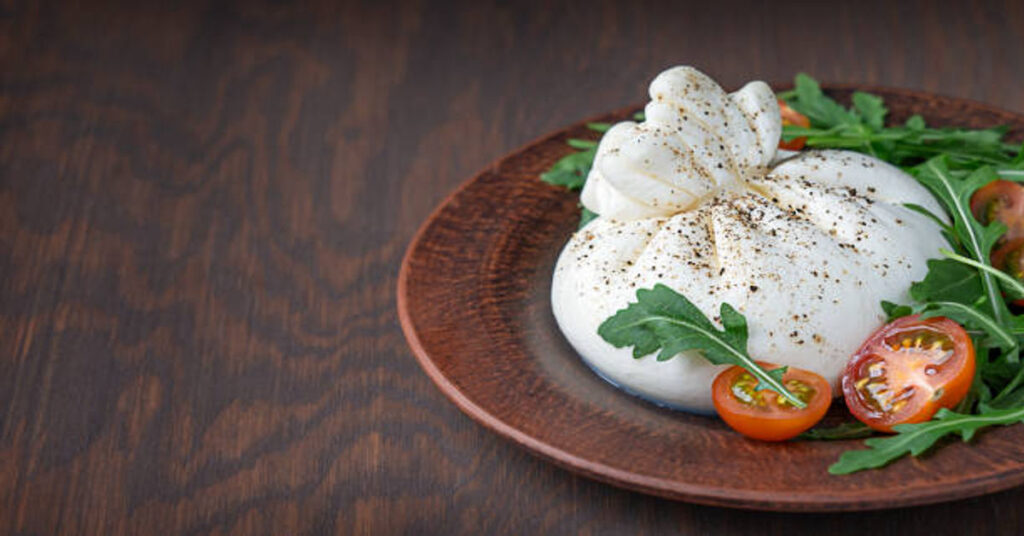Among Italy’s most prized culinary creations, few foods captivate the senses quite like Burrata cheese. With its velvety texture, delicate outer shell, and irresistibly creamy core, Burrata represents the perfect harmony between craftsmanship and indulgence. Although it shares similarities with fresh mozzarella, Burrata offers a sensory depth that elevates it to a category of its own. Its rich interior—made of stracciatella and cream—literally melts on the tongue, transforming simple dishes into luxurious experiences.
This article explores Burrata in depth: its origins, how it is made, its unique flavor profile, its nutritional aspects, and the many ways it can be enjoyed. Along the way, we’ll uncover why Burrata has become a global favorite while maintaining its deeply traditional Italian roots.
1. The Origin and History of Burrata
The story of Burrata begins in the southern Italian region of Apulia (Puglia), specifically in the province of Andria, during the early 20th century. It is believed that Burrata was born from both necessity and creativity—as a way for cheesemakers to use leftover mozzarella curds and cream rather than waste them.
During the cold months, farmers and cheesemakers often faced challenges in preserving milk and curds due to limited refrigeration. One inventive artisan decided to wrap the leftover curds and fresh cream inside a thin pouch of mozzarella, sealing it tightly to preserve freshness. This practical idea turned out to be a culinary revelation. The result was a soft, pouch-like cheese that not only stored well but delivered a rich, indulgent flavor unlike any other.
In the decades that followed, Burrata became a local specialty enjoyed mainly within Puglia. Its popularity spread gradually across Italy and then internationally as travelers and chefs discovered its extraordinary texture and taste. Today, Burrata remains a symbol of Italian artisanal skill—handcrafted using traditional methods passed down through generations.
2. Understanding What Burrata Really Is
At first glance, Burrata might seem similar to mozzarella, but the two differ significantly in both composition and texture. While mozzarella is entirely solid, Burrata has a dual nature—solid on the outside and creamy on the inside.
| Feature | Mozzarella | Burrata |
|---|---|---|
| Texture | Firm and elastic | Soft outer shell with creamy center |
| Flavor | Mild, milky | Rich, buttery, slightly tangy |
| Composition | Entirely curd-based | Outer mozzarella shell filled with cream and stracciatella |
| Shelf Life | Longer | Very short, must be consumed fresh |
| Origin | Campania | Apulia |
The name Burrata itself comes from the Italian word burro, meaning “butter.” This is a fitting description, as its taste and texture evoke the smoothness of fresh butter.
3. The Craft of Making Burrata
The process of creating Burrata remains largely handcrafted, even in modern production facilities, because precision and touch are crucial to achieving its distinctive consistency. The artistry lies in balancing firmness and creaminess—an art form that reflects generations of Italian cheesemaking heritage.
The basic ingredients include cow’s milk, rennet, citric acid or starter cultures, cream, and salt. The process can be summarized in the following stages:
| Step | Description |
|---|---|
| 1. Milk Preparation | Fresh cow’s milk is gently heated and mixed with rennet to form curds. |
| 2. Curd Formation | Once curds form, they are cut into small pieces to release whey. |
| 3. Stretching (Pasta Filata) | The curds are placed in hot water and stretched until smooth and elastic—this becomes the mozzarella base. |
| 4. Forming the Pouch | The mozzarella is shaped into a thin pouch while still warm and pliable. |
| 5. Filling with Stracciatella | Stracciatella—a mixture of shredded mozzarella and cream—is spooned into the pouch. |
| 6. Sealing and Cooling | The pouch is sealed at the top and quickly submerged in cold water to hold its shape. |
The finished Burrata is typically stored in a light brine or whey solution to maintain its delicate moisture. Because it contains fresh cream, Burrata should ideally be consumed within 48 hours of production for the best flavor and texture.
4. The Sensory Experience of Burrata
Burrata is a multi-layered experience for the senses. When you cut through its soft, milky exterior, a luscious, creamy center oozes out—a sight that delights cheese lovers everywhere.
The flavor is subtle yet indulgent, combining the freshness of milk with the richness of cream. It carries a faint sweetness balanced by a gentle tang, making it both comforting and sophisticated. The texture transitions from elastic at the surface to velvety smooth inside, creating a dynamic mouthfeel that distinguishes it from any other cheese.
In Italy, Burrata is often described as un viaggio nel gusto—a “journey of taste”—because it unfolds gradually: first the mild mozzarella, then the decadent cream, and finally the lingering buttery finish.
5. Nutritional Profile of Burrata
Although Burrata is considered a rich cheese, it provides valuable nutrients when consumed in moderation. It offers a good source of protein, calcium, and vitamins, while also being a satisfying treat for those who appreciate dairy-based delicacies.
| Nutrient (per 100g) | Approximate Value |
|---|---|
| Calories | 300–340 kcal |
| Protein | 12–14 g |
| Fat | 25–28 g |
| Carbohydrates | 2–3 g |
| Calcium | 350–400 mg |
| Vitamin A | 250–300 µg |
| Sodium | 250–300 mg |
Because Burrata is high in fat, it is best enjoyed as part of a balanced diet—paired with vegetables, whole grains, or fruits to create nutritional balance. Its richness means that even small portions deliver satisfaction and flavor.
6. Types and Variations of Burrata
While traditional Burrata is made from cow’s milk, variations exist depending on region and milk source.
| Type | Milk Source | Flavor Characteristics | Common Uses |
|---|---|---|---|
| Burrata di Andria (Traditional) | Cow’s milk | Creamy, buttery, authentic | Fresh salads, antipasti |
| Burrata di Bufala | Buffalo milk | More intense, tangy, richer | Gourmet dishes, fine dining |
| Smoked Burrata | Cow’s milk | Lightly smoky aroma | Paired with cured meats |
| Truffle Burrata | Cow’s milk with truffle essence | Earthy, luxurious flavor | Pasta dishes, risottos |
The Protected Geographical Indication (PGI) label, Burrata di Andria IGP, guarantees the authenticity of Burrata made following traditional methods in Apulia.
7. How to Serve and Enjoy Burrata
The beauty of Burrata lies in its versatility. It can be served fresh on its own or used to elevate a variety of dishes—from simple salads to complex gourmet meals.
When serving Burrata, it should be room temperature to ensure the creamy interior flows perfectly when cut. Cold Burrata can feel stiff and less flavorful.
Classic Serving Ideas:
- With Tomatoes and Basil: Burrata pairs wonderfully with ripe tomatoes, fresh basil, and olive oil—an elevated version of the classic Caprese salad.
- On Pizza: Added after baking, Burrata melts delicately over the crust, creating a luxurious finish.
- With Grilled Vegetables: Its creaminess balances the smoky notes of roasted peppers, zucchini, and eggplant.
- On Bread or Crostini: Spread over warm bread with a drizzle of balsamic glaze or truffle oil for an indulgent appetizer.
- With Fruit: Paired with figs, peaches, or strawberries, it creates a stunning sweet-salty contrast.
Pro Tip: Never cook Burrata directly, as heat destroys its creamy texture. Always add it after cooking or just before serving.
8. Wine Pairing and Flavor Complements
Burrata’s creamy texture and mild sweetness pair best with wines and accompaniments that balance its richness without overpowering it.
| Pairing Category | Examples | Flavor Interaction |
|---|---|---|
| White Wines | Pinot Grigio, Sauvignon Blanc, Vermentino | Crisp acidity complements creaminess |
| Red Wines | Chianti, Barbera, Pinot Noir | Light tannins add structure without heaviness |
| Rosé Wines | Dry Provençal or Italian Rosé | Enhances freshness and subtle sweetness |
| Accompaniments | Olive oil, sea salt, balsamic reduction, arugula | Adds depth and contrast |
For a non-alcoholic pairing, sparkling water with lemon or herbal iced tea works beautifully, providing a refreshing contrast to Burrata’s velvety mouthfeel.
9. Burrata Around the World
Although Burrata originated in Italy, it has gained immense popularity worldwide, becoming a staple in fine dining and home kitchens alike. Chefs across continents have embraced it as a symbol of luxurious simplicity—a food that transforms any dish into something special.
In the United States, Burrata has found a loyal following in farm-to-table restaurants, where it is paired with local produce and artisanal bread. In France, it appears in gourmet platters alongside charcuterie and seasonal fruits. Even in Asia, innovative chefs incorporate Burrata into sushi rolls, fusion salads, and modern desserts.
Despite its global fame, authentic Burrata from Apulia remains unmatched in flavor and texture—proof that tradition often outshines imitation.
10. Storage, Shelf Life, and Handling Tips
Burrata is a fresh cheese, meaning it is best consumed within days of production. Its delicate structure and cream content make it sensitive to temperature and time.
| Condition | Storage Recommendation |
|---|---|
| Unopened Burrata | Keep in its brine, refrigerated at 4°C (39°F). |
| Opened Burrata | Consume within 24 hours; store submerged in whey or light saltwater. |
| Do Not Freeze | Freezing ruins its texture and flavor. |
| Before Serving | Remove from refrigerator 30 minutes before eating to reach room temperature. |
Proper storage ensures Burrata maintains its luscious consistency and authentic taste until serving time.
11. Burrata in Modern Cuisine
Modern chefs have reimagined Burrata in countless creative ways, combining traditional flavors with contemporary presentation. It often serves as the centerpiece of a dish, drawing attention with its pure white color and soft structure.
Contemporary Uses Include:
- Burrata with Beet Carpaccio: The sweetness of roasted beets contrasts beautifully with Burrata’s creaminess.
- Pasta with Burrata Sauce: Torn Burrata added after cooking turns warm pasta into a silky, decadent meal.
- Burrata-Topped Risotto: Creamy risotto crowned with Burrata delivers texture harmony.
- Seafood Pairings: Paired with shrimp, scallops, or smoked salmon for a delicate surf-and-cream experience.
- Dessert Innovation: Some chefs even incorporate Burrata with honey, nuts, and fruit compotes as a dessert component.
In essence, Burrata’s adaptability bridges rustic simplicity and modern elegance, making it a universal favorite.
12. Burrata vs. Other Soft Cheeses
While Burrata shares traits with other soft cheeses, it stands apart in construction and taste.
| Cheese | Texture | Flavor | Distinct Feature |
|---|---|---|---|
| Mozzarella | Smooth, elastic | Mild and fresh | Entirely solid curd |
| Ricotta | Grainy, light | Sweet and mild | Made from whey, not curds |
| Cream Cheese | Dense, spreadable | Slightly tangy | Blended and homogenized |
| Burrata | Cream-filled pouch | Buttery, luxurious | Outer mozzarella with creamy core |
Each has its culinary role, but Burrata’s combination of stretchiness and creaminess remains unique.
13. Health Considerations
While Burrata is undeniably rich, it can still be part of a healthy diet when consumed thoughtfully. Its protein content supports muscle repair, and calcium contributes to bone health. However, its high fat and sodium levels suggest moderation is key.
Those with lactose intolerance may find Burrata easier to digest than aged cheeses, though it still contains lactose. Choosing smaller portions or pairing Burrata with fiber-rich foods can create balance. Additionally, when paired with fresh produce like tomatoes, leafy greens, or fruit, Burrata forms part of a wholesome Mediterranean-inspired diet.
14. Sustainability and Ethical Production
With rising demand, sustainability has become crucial in Burrata production. Many artisanal dairies now emphasize:
- Local milk sourcing, reducing transportation emissions
- Humane animal care, ensuring quality milk and ethical standards
- Biodegradable packaging, maintaining freshness without harming the environment
- Minimal waste, reusing whey and by-products for animal feed or compost
Supporting small-scale dairies not only ensures authenticity but also promotes fair trade and environmental stewardship.
15. Conclusion: The Legacy of Burrata
Burrata is more than a cheese—it is a culinary expression of craftsmanship, simplicity, and indulgence. From its humble origins in Apulia’s countryside to its presence on global menus, Burrata continues to symbolize the soul of Italian cuisine: taking the simplest ingredients—milk, cream, salt—and transforming them into something divine.
Every slice reveals the artistry of the cheesemaker and the passion of a culture that values both tradition and innovation. Burrata teaches us that food can be both comforting and luxurious, rustic yet refined. Whether enjoyed on a summer salad, atop a warm pizza, or paired with fruit and honey, Burrata offers an experience that is timeless, rich, and unforgettable.
FAQs
1. What is Burrata cheese made of?
Burrata is made from cow’s milk, mozzarella curds, fresh cream, and stracciatella (shredded mozzarella). It has a solid outer shell and a creamy interior.
2. How is Burrata different from mozzarella?
Unlike mozzarella, which is entirely solid, Burrata contains a soft center filled with cream and curd shreds, offering a richer flavor and texture.
3. How should Burrata be stored and served?
Store Burrata in its brine in the refrigerator and serve it at room temperature to release its creamy texture and full flavor.
4. What foods pair best with Burrata?
Burrata pairs beautifully with tomatoes, basil, olive oil, roasted vegetables, fruits, crusty bread, and light wines.
5. Is Burrata healthy?
Burrata is nutritious in moderation—it provides protein and calcium but is high in fat, so portion control is recommended.







